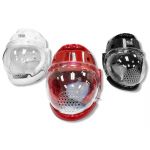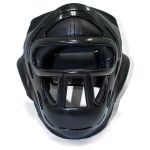Martial Arts Headgear for Karate & Taekwondo Sparring
-
$24.95
-
$39.95
-
$34.95
-
$79.95
-
$89.95
-
$59.95
Martial arts headgear has evolved a lot over the years. In the early days of point sparring, competitors wore almost no padding at all, just gloves and maybe a chest protector. As safety standards tightened and injuries piled up, headgear became the norm. Today, you've got options for every training style and contact level. Foam-dipped karate headgear is still the classic choice for point-style sparring. It's lightweight, breathable, and surprisingly effective at absorbing impact during fast-paced exchanges. Most of our traditional taekwondo headgear falls into this category too, which makes sense since taekwondo matches often involve a lot of quick, high kicks, so good head coverage is a must.
But if you're training in a full-contact discipline like MMA or boxing, you'll probably want something beefier. MMA training headgear usually comes with thicker padding and added protection around the cheeks and jaw. Some models even include a vinyl face cage or polycarbonate face shield to protect your nose and eyes from strikes. The turtle-style headgear we carry has become a favorite for people who want full coverage without sacrificing visibility. It wraps around the head like a shell and includes a large, clear face shield that protects the front of the face while keeping your line of sight wide open. It's a great option for those who don't want to flinch every time a glove comes flying in their direction.
You'll also find taekwondo head protectors with reinforced ears and ventilation channels to keep your head cool while you're training hard. A good taekwondo head guard strikes that balance between comfort and coverage, letting you move freely without feeling like your head is trapped in a sauna. If you train in both karate and taekwondo, there's a good chance you'll want a head protector that can hold up across multiple disciplines. That's where vinyl sparring headgear comes in. It's a little more rigid than foam, often includes extra ear padding, and some models even allow you to attach or remove a face shield depending on the drill.
Choosing the right martial arts headgear comes down to more than just price or looks. Every style of head guard we offer is built with a specific purpose in mind. Foam headgear works great for lighter sparring, especially in youth classes or for kata tournaments where strikes are controlled. Martial arts head guards made from vinyl or leather-style materials offer better durability and impact resistance for more intense drills. And if you're recovering from a facial injury or just want to keep your nose intact, a polycarbonate face shield adds that extra layer of protection without compromising your awareness.
One thing that often gets overlooked is how different headgear feels once you start moving. Some karate head guards have open tops for ventilation, while others fully encase your head to minimize any exposed surface. Some martial arts head protectors prioritize ear protection, which is a must if you're doing a lot of grappling or close-range training where accidental elbow contact can happen. And while you can technically spar without a face shield, the first time you catch a roundhouse to the mouth, you might wish you had one. Luckily, we carry multiple headgear styles with removable clear shields, so you can adapt your setup to whatever intensity you're training at.
Parents shopping for youth taekwondo headgear should pay close attention to sizing and protection level. Most youth head guards follow similar safety standards as adult gear but are sized down for a more secure fit. It's not just about comfort, it's about making sure the headgear doesn't shift during impact or block their vision while sparring. We've seen more than a few kids struggle with oversized gear, which can throw off their timing and confidence. That's why our karate head protectors come in multiple sizes and designs to fit both kids and adults properly.
Before choosing a taekwondo head protector or a karate head guard, think about how much contact you're expecting and what rules your school or competition follows. Gear that works in one martial art may not be allowed in another. Sizing, visibility, and ear protection are especially important for younger students. If you're unsure, start by checking with your instructor. They can point you toward the right type of martial arts head guard for your specific needs. Good headgear won't make you a better fighter, but it will let you train harder and longer without worrying about unnecessary injuries.
What's the difference between foam and vinyl sparring headgear?
Foam headgear is usually made from lightweight, closed-cell foam that's been dipped in a protective coating. It's breathable, flexible, and designed for light to moderate contact, which makes it a popular choice for point sparring, kids classes, and beginner training. Foam gear is comfortable, easy to put on, and allows for good ventilation, but it can wear out faster with heavy use.
Vinyl sparring headgear, on the other hand, has a tougher outer shell made of synthetic leather or coated vinyl. It's built for durability and can take a lot more punishment. Many vinyl models include added ear protection, thicker padding, or attachment points for face shields or cages. This type of headgear is better suited for harder contact and longer-lasting use, especially in schools that do more aggressive drills or allow full-speed sparring.
Is headgear required for taekwondo competitions?
Yes, headgear is typically required in taekwondo competitions, especially for youth and amateur divisions. Most tournaments follow World Taekwondo or ITF rules, both of which mandate protective headgear for safety. The specific style of taekwondo headgear you'll need depends on the organization and the level of contact allowed.
Most events call for foam or vinyl taekwondo head guards with open-face designs and reinforced ear padding. Some higher-level tournaments allow clear face shields, but others may restrict them. If you're competing, always double-check the rules ahead of time to make sure your gear is legal. Tournament-approved headgear is often white or color-matched to your uniform, and it usually needs to be free of logos or extra attachments.
Can I use the same headgear for karate and MMA training?
You can, but it depends on how intense your training is and what kind of protection you need. Foam karate headgear works great for light contact sparring, especially in traditional dojos or point-based tournaments. It's lightweight, easy to move in, and designed for speed and control.
MMA training, on the other hand, usually involves heavier contact, striking to the face, and sometimes grappling. That means you'll want headgear with more padding around the cheeks, chin, and back of the head. Many MMA styles of headgear also include a face bar or cage to prevent cuts and broken noses.
If you're cross-training in both styles and doing light sparring, a durable vinyl martial arts head guard might cover both needs. But if you're taking full-contact shots in MMA, it's worth getting dedicated gear for that purpose.
How do I know what size headgear to buy?
Most martial arts headgear is sized based on head circumference, so the best way to find your size is to use a flexible measuring tape around your forehead, just above your eyebrows and ears. Compare that measurement to the sizing chart provided by the manufacturer. If you're between sizes, it's usually better to size up for comfort and adjust the fit using the straps or closures.
Headgear should feel snug but not tight. It shouldn't slide around when you move, and it definitely shouldn't pinch or press hard on your temples. If the ear holes aren't aligned with your ears, or the forehead padding shifts during movement, it's likely the wrong size. For kids, always double-check the fit before sparring, since too-loose gear can shift on impact and block vision.
Does headgear actually prevent concussions?
Not completely. Martial arts headgear is designed to reduce the force of direct impacts, protect against cuts, and shield areas like the nose, ears, and jaw. It can definitely help reduce the risk of surface injuries and make sparring safer overall. But when it comes to concussions, no headgear can fully eliminate the risk.
A concussion happens when the brain moves inside the skull due to a sudden impact or jolt. Padding can soften the blow, but it can't stop your head from snapping back or rotating sharply. So while headgear lowers the chances of visible injuries, you still need to train smart, avoid reckless contact, and use control during drills, especially in full-contact settings.
What kind of headgear is best for kids?
For kids, the best headgear is lightweight, well-ventilated, and properly sized to stay secure during movement. Foam-dipped sparring headgear is often the go-to for youth martial arts because it's comfortable, easy to put on, and designed for light contact. It offers solid protection for the forehead, sides, and back of the head without adding a lot of bulk or weight.
Many kids karate head guards also include reinforced ear padding to protect against accidental strikes during drills. If the school allows or recommends face protection, look for headgear with a built-in clear shield or one that allows optional cage attachments. The most important thing is that it fits well. Loose or oversized gear can block vision or slip during sparring, which can be more dangerous than not wearing headgear at all.
Are face shields or cages necessary for beginners?
Not always, but they can be a smart choice, especially for younger students or anyone nervous about getting hit in the face. Most beginners start with light contact drills, where foam headgear without a face shield is usually enough. But if your school includes any accidental contact to the nose, mouth, or eyes during sparring, a clear polycarbonate face shield or vinyl cage can add peace of mind.
Face protection becomes more important when you're working on close-range techniques or if you wear braces, glasses, or have a history of facial injuries. Some headgear styles come with removable shields, so you can ease into sparring without feeling boxed in. It's a good idea to ask your instructor what level of contact to expect so you can choose gear that matches the pace of your training.
How do I clean and sanitize sparring headgear?
Start by wiping the headgear down with a damp cloth after each use to remove sweat and debris. For deeper cleaning, use a gentle soap and warm water, or a non-abrasive disinfectant spray that's safe for sports gear. Make sure to get into areas around the ears, chin strap, and any face shield attachments where bacteria can build up.
Let the headgear air dry completely before storing it. Never toss it in a gym bag while it's still damp, or you'll end up with mildew and a bad smell that's tough to get rid of. If your headgear has a removable face shield, clean it separately with a soft cloth and mild cleaner to avoid scratching the surface. Regular cleaning not only keeps your gear hygienic, it also helps it last longer.
What's the best headgear for people with glasses?
If you wear glasses, standard open-face headgear can be a problem. Most styles aren't designed to fit comfortably over frames, and the risk of your glasses shifting or breaking during sparring is high. The better option is headgear with a built-in clear face shield or cage that creates space between your face and any impact. These designs help protect your glasses and your face at the same time.
That said, many martial artists who wear glasses choose to train without them and instead use contact lenses or just go without vision correction during sparring. If neither of those options works for you, make sure your headgear is large enough to fit over your frames without pinching, and test it out in class drills before sparring at full speed.
Is the turtle-style headgear good for full-contact sparring?
Yes, turtle-style headgear is one of the better options for full-contact sparring, especially if you're concerned about facial injuries. It typically features full wraparound foam padding along with a large, clear polycarbonate face shield that covers the nose, mouth, and eyes. That combination offers a solid balance of visibility and protection.
Because of its full-coverage design, this style is often used in high-contact drills, youth classes, and by anyone recovering from a facial injury. It's bulkier than traditional open-face headgear, but it absorbs impact well and adds a layer of safety where you need it most. Just make sure it fits securely and doesn't shift during movement, since the added weight can sometimes cause slipping if the straps aren't tight enough.
Can I use boxing or MMA headgear in a karate class?
Sometimes, but not always. Boxing and MMA headgear usually has bulkier padding, especially around the cheeks and jaw, and is designed for continuous striking. That can be overkill in a traditional karate setting, where sparring is often light contact and focused on speed and control. Some karate instructors may even prohibit boxing-style headgear if it limits visibility or doesn't meet the school's uniform standards.
If your karate school allows it, MMA headgear with a low-profile design and clear visibility can work fine. But it's always best to check with your instructor before using gear from another discipline. Traditional karate head guards are usually lighter and more open, making them better suited for fast-paced point sparring and kata-based drills.
Will headgear protect me from nose injuries?
It depends on the type of headgear you're using. Standard foam or vinyl sparring headgear offers some protection around the sides of the face and forehead but leaves the nose exposed. That means you can still take a direct hit to the nose during sparring if you're not careful.
If nose protection is a priority, look for headgear with a built-in face shield or cage. A clear polycarbonate shield covers the entire front of the face without blocking your vision, while a vinyl or metal cage adds extra padding and space between your face and incoming strikes. These styles significantly reduce the risk of broken noses, cuts, and facial swelling during full-contact training. They're especially useful for beginners or anyone recovering from a previous injury.





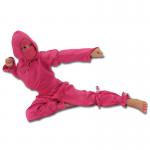
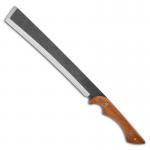



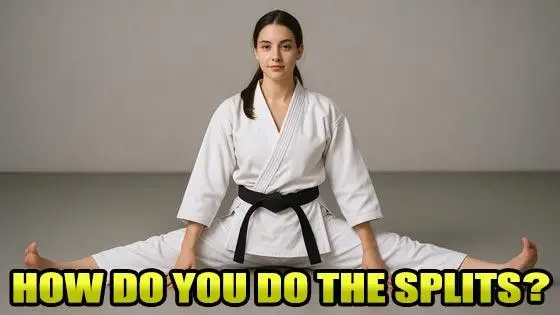

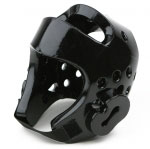

 (1)
(1)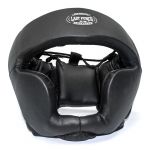
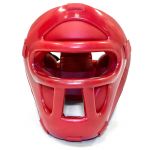
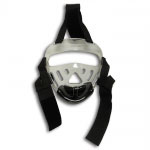
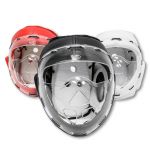
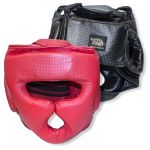
 (2)
(2)